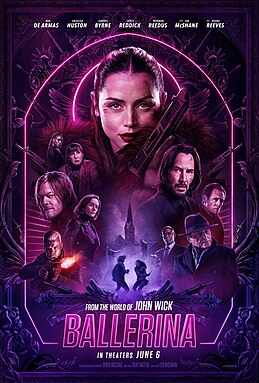Eye For Film >> Movies >> Ballerina (2025) Film Review
Ballerina
Reviewed by: Andrew Robertson

When John Wick first hit screens 11 years ago it was clear that its cocktail of visceral violence and secret societies dedicated to criminal conspiracy was one with punch. That it'd leave not one, not two, but three increasingly high-concept films in its bloody wake was not something anyone would have thought were in its sights. Though its aims were perhaps more instinctual, from the hip and not the head.
Ballerina expands upon scattered details of what needs a better name than "the World of John Wick" or the JWCU. That first seems like it's a catalogue of kitschy figures and tchotchkes or children's books, and the latter some mistranscribed engraving in an abandoned church. Ballerina might have both to give.

John Wick set a prototype that nobody quite managed to follow, but plenty have tried. We've had a whole suite of professions from accountants to bricklayers, a menagerie from sparrows to spiders and monkeys, even hairstyles and seasonings. It's harder still when the act you're trying to follow has had its third and final.
In the same way that Hannibal Lecter is perhaps less a serial killer than a Dracula, a distinct thing that's like a vampire but, as Renfield would advise, quite different, the hit-men and assassins of John Wick's world are effectively supernatural entities. That when The Matrix was reloaded the Wachowskis suggested this already doesn't make it less entertaining. These secretive groups have strict rules and rituals, they might be mercenaries but there's magic in their ways and means.
There are endless mentions of fates, though the Norns presumably answered a wanted ad that asked for Rockabilly telephonists for an exchange where you can Dial M For Murder but also have option A for assassination and B for bloodshed and C for contract killing like an alphabet book for babies. Some of these mentions are made by Ian McShane who in flashbacks and scenes contemporary to his previous appearances reprises the role of Winston, operator of New York's Continental Hotel. He's got competition from Gabriel Byrne in the hangdog stakes, and elsewhere too, as the Chancellor is among our eponymous heroine's antagonists. Indeed he's part of her origin story.
It's in the blood, it's fate, it's a choice, they say, as they navigate an underworld that's got more than a touch of the underworld. Fitting, perhaps, that for this they've brought in the man who directed Underworld though director Len Wiseman has form for lacklustre outings for tired franchises and washed out versions of things we've seen before. Writer Shay Hatten penned Wicks three and four, and also contributed to the Rebel Moon saga.
Old hands like Anjelica Huston, Byrne and McShane have spouted speeches this clumsy before and still bring charisma to it all. Ana de Armas and Keanu Reeves not only have to deliver dodgy dialogue but get bounced off the scenery in between trying not to chew it. It is, ultimately, the stuntwork and fight choreography that make Ballerina worth watching, and there's plenty of both.
Ignore, for the moment, the intense colour grading and strobe warning at the start. Pity the nine effects firms whose multiple contributions will be overshadowed by a certain weightlessness to a couple of CG vehicles that deliver fresh foes to fight like video-game cut-scense. Focus instead, when occasionally over-enthusiastic camerawork allows, on two dozen or so sequences of balletic mayhem.
There's a nod to the sommelier from earlier in the franchise and the Butcher from Baby Driver, plenty of moments of the "john wick flick" to clear magazines from wells, and enough improvised weapons to cover the walls of a theme restaurant. A test was reminiscent of New Police Story but Jackie Chan's influence is felt every time someone lamps someone with whatever they light upon first. As the action escalates one might feel the story was painting itself into a corner but it never quite becomes a prisoner of its mounting tension. As it ratchets up its body count it brings in Norman Reedus to add to the collection of folk who've had hard paper rounds.
That's in contrast to de Armas who would look young in comparison with her cast-mates even if she wasn't wide-eyed in the service of vengeance. Her training is to make her a Kikimora, but you'd be as well to go off and investigate that suite of legends separately because they're about as able a reflection of those features as an iron mask. We're not given a message that her character will return, it's harder to get an appointment now than with Dr No, but the door is (if not literally) left open.
Among the films many portals are hotels whose doors are round like hobbit holes and ringed with carmine neon. That's one of several clear nods to other films and for all its acrobatics and to get the the point Ballerina isn't, perhaps can't, stand on its own. It's no less entertaining for it, when we're told "One bullet well placed can be a magical thing," it feels less metaphorical than metaphysical. The relative conjuring powers of hand grenades in melee or frying pans to the face aren't left as an exercise to the reader - you can watch and learn.
The action sequences have several highlights, though they're kept company by some bloody training montages. An early nightclub fight ends up somewhat lacklustre, despite the quantity of reflective surfaces in the frozen landscape of Minus Eleven. Resembling a rejected retreat for Mr Freeze from Joel Schumacher's Batman And Robin, it's massively overshadowed by a later nightclub sequence that shows us violence in the past-tense. Not as flashback, but as our protagonist retraces her steps, collecting and recollecting until we too get the point. Its quality is almost immediately undercut by another moment of that weightless computer graphics, one that exposes the artificiality of production mostly done on soundstages. You will absolutely believe every kick, punch, and close-range shot, but that makes the presence of a vintage yellow cab in front of a green-screen building feel less old-fashioned than out of touch.
Perhaps the most apposite of the armaments on display is a knife duct-taped to the grip of a pistol. It's ungainly, even unnecessary, but it's brutally effective. It may not be efficient, it's definitely derivative like any set of things lashed together must be, but it gets the job done. Ballerina might not have a high bar to clear, but it does it with some style.
Reviewed on: 12 Jun 2025


















